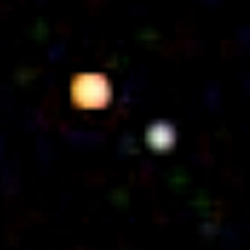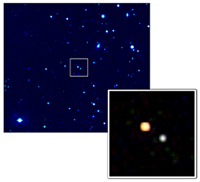March 13, 2002
RELEASE: 02-03
Scientists have unraveled a longstanding mystery about a rare double quasar system 11 billion light years from Earth using NASA's Chandra X-ray Observatory. These "twin" quasars, previously thought to be an optical illusion, were instead probably created by merging galaxies and may have been more common in the dense universe soon after the Big Bang.
"When galaxies interact or merge, they become more active and luminous and can excite quasar activity in their centers," said Paul Green of the Harvard-Smithsonian Center for Astrophysics, Cambridge, Mass., who led the research team. "The quasars that make up these nearly identical twins appear to have been hatched in the same nest."
The Chandra data show that the quasars - luminous galaxies powered by central supermassive black holes - are not mirror images caused by a cosmic phenomenon known as a "gravitational lens." Rather, these two quasars are distinct objects that were probably spawned when their host galaxies collided, energizing the flow of gas onto their central black holes.
Quasar pairs that are seen close to one another on the sky and are at the same distance from Earth often turn out to be an illusion as part of a gravitationally lensed system. In these cases, the image of a single quasar has been split into two or more images as its light has been bent and focused on its way to Earth by the gravity of an intervening massive object like a galaxy, or a cluster of galaxies.
Usually, the intervening mass shows up as a fainter galaxy or cluster of galaxies seen between or among the quasar images, confirming the cause of the illusion. The quasar pair Q2345+007 A, B was thought to be such an illusion because of the remarkably similar patterns of the light, or spectra, from the pair at both optical and ultraviolet wavelengths.
However, almost two decades after its discovery by optical astronomers, the identification of enough intervening material to "split" the image of a single quasar into an apparent double has proved fruitless. This led to the speculation that the gravitation light-bending might be caused by a new type of cluster that contained hot gas and dark matter, but failed to ever make stars or galaxies. Such a "dark cluster" would be invisible to optical and ultraviolet telescopes, but would be detectable in X-rays.
The Chandra images, the most sensitive ever taken for this type of search, showed no evidence for a massive dark cluster. Further, the X-ray spectra of the two quasars were distinctly different.
"This may mean that the pair Q2345+007A,B actually consists of two separate quasars," said Green. "However, a mystery remains. How can two quasars have identical optical spectra - every bump and wiggle? The coincidence seems improbable."
One possible explanation is that the quasars are formed close by each other grow up to look alike at optical wavelengths, but that X-rays which probe closer to their central black holes, bring out the individual differences.
Chandra observed Q2345+007 on May 26, 2000, for 65,000 seconds using the Advanced CCD Imaging Spectrometer instrument. Scientists from the Harvard-Smithsonian Center for Astrophysics and the National Optical Astronomy Observatory were also members of the research team.
The ACIS camera was developed for NASA by Pennsylvania State University, University Park, Pa., and the Massachusetts Institute of Technology, Cambridge, Mass. NASA's Marshall Space Flight Center in Huntsville, Ala., manages the Chandra program. TRW, Inc., Redondo Beach, Calif., is the prime contractor for the spacecraft. The Smithsonian's Chandra X-ray Center controls science and flight operations from Cambridge. The National Optical Astronomy Observatory is operated by the Association of Universities for Research in Astronomy (AURA), Inc., under a cooperative agreement with the National Science Foundation.
MEDIA CONTACTS
Steve Roy
Marshall Space Flight Center, Huntsville, AL
Phone: 256-544-6535
Megan Watzke
Chandra X-ray Observatory Center, CfA, Cambridge, MA
Phone: 617-496-7998




